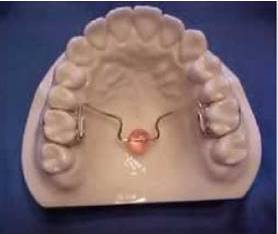Many orthodontists have had the discouraging experience of completing dental treatment, with what appeared to be good results, only to discover that the case had relapsed because the patient had a tongue thrust swallowing pattern. If the tongue is allowed to continue its pushing action against the teeth, it will continue to push the teeth forward and reverse the orthodontic work. The force of the tongue against the teeth is an important factor in contributing to malformation (“bad bites”).
Tongue thrusting is the habit of thrusting the tongue forward against the teeth or in between while swallowing. It is normal for infants to thrust their tongues between their gums but by the age of 6, normal swallowing patterns should be developed. A normal swallowing pattern involves squeezing the tongue against the roof of the mouth instead of pushing it forward against the teeth. For tongue thrusters, the constant pressure of the tongue pressing up against the teeth during each swallow and even at rest causes a number of different problems and will force the teeth out of alignment.
There are several different types of tongue thrust and resultant orthodontic problems:
• Anterior open bite – the most common and typical type of tongue thrust. In this case, the front lips do not close and the child often has his mouth open with the tongue protruding beyond the lips. In general, it has been noted that a large tongue usually accompanies this type of tongue thrust.
• Anterior thrust – upper incisors are extremely protruded and the lower incisors are pulled in by the lower lip. This particular type of thrust is most generally accompanied by a strong mentalis (muscle of the chin).
• Unilateral thrust – the bite is characteristically open on either side.
• Bilateral thrust – the anterior bite is closed; however the posterior teeth from the first bicuspid to the back molars may be open on both sides. This is the most difficult thrust to correct.
• Bilateral anterior open bite – the only teeth that touch are the molars with the bite completely open on both sides including the anterior teeth. Once again a large tongue is also noted.
• Closed bite thrust – typically shows a double protrusion meaning that both the upper and lower teeth are flared out and spread apart.
When a tongue thrust exists, the upper arch collapses from improper lateral development usually provided from a normal posturing tongue. A patient with a tongue thrust often has difficulties with speech, especially the “S” and “Z” sounds. The patient is often a mouth breather, and when at rest, rests with their mouth open with a forward tongue position. Tongue thrusters will often make a funny face when swallowing or appear to be frowning. Most tongue thrusters are unable to “Click” with their tongues.

It is important to recognize tongue thrusting during early development so that the behavior can be retrained and cause less damage to the bite and speech patterns. Dr. Adler is available for complimentary consultations regarding tongue thrusting and orthodontics. Please call the office at 303-449-1119 to schedule.
